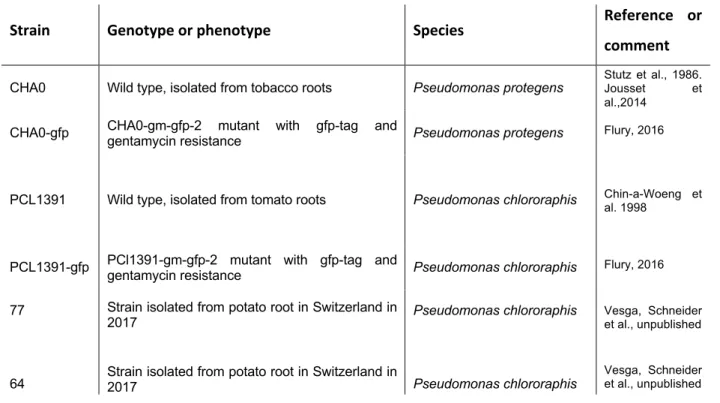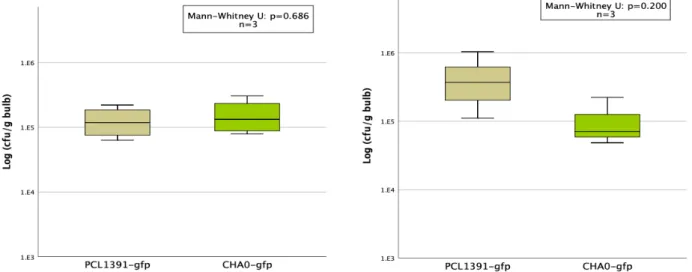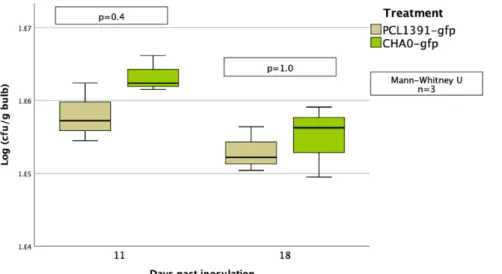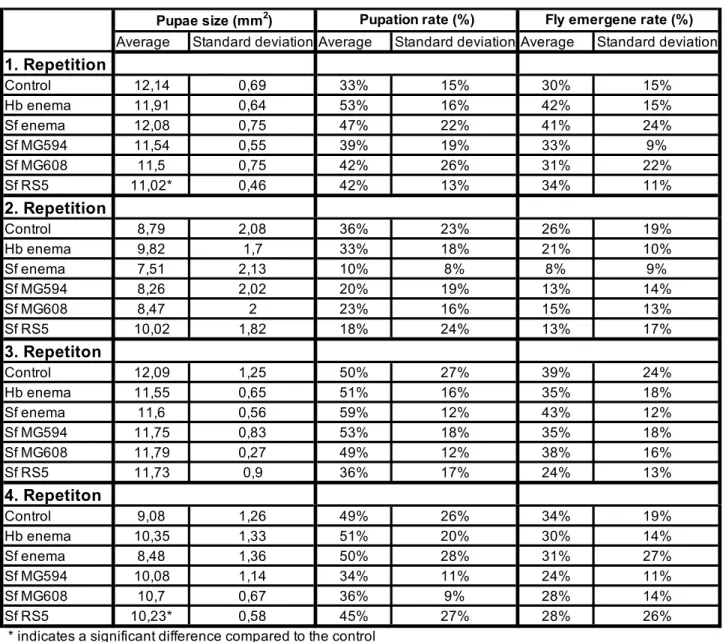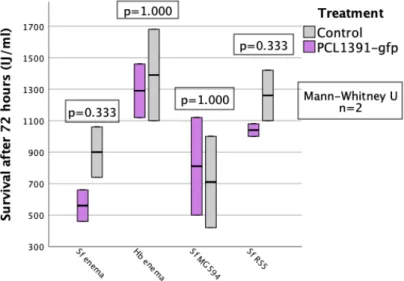Working with her was always fun and very interesting, no matter if it was in the field or in the lab, I learned a lot from her. Entomopathogenic nematodes (EPN) and entomopathogenic pseudomonads (EPP) are the most promising for the control of soil-borne pests such as D. In this study, the compatibility of EPNs and EPPs as well as their potential for the control of the cabbage root fly D.
Treatments with five EPN strains under controlled climate chamber conditions showed inconsistent effects on pupation rate and fly emergence of D. In vivo compatibility experiments of EPN and EPP showed no antagonistic effects on mortality of G.
INTRODUCTION
- S OIL BORNE INSECT PESTS - WHY ARE THEY SO HARD TO CONTROL ?
- D ELIA RADICUM : AN IMPORTANT PEST ON B RASSICACEAN CROPS
- Biology of D. radicum
- Damage caused by D. radicum
- Current measurements against D. radicum
- B IOLOGICAL CONTROL AGENTS AS AN ALTERNATIVE CONTROL METHOD
- Entomopathogenic nematodes
- Pseudomonads as entomopathogens
- C OMBINING B IOLOGICAL C ONTROL A GENTS
- Challenges when combining nematodes and pseudomonads
- D ESCRIPTION OF THE PROJECT “B ENE C OMB ”
The host range and pathogenicity strongly depend on the symbiosis of the nematode with the bacteria (Grewal et al., 2008). But the molecular basis and regulation of this insecticidal activity remains largely unclear (Kupferschmied et al., 2013). The gene encoding the actual insect toxin is called FitD (Péchy-Tarr et al., 2008).
Biocontrol agents can complement each other when environmental factors change or favor one of them (Xu et al., 2011). There, disease control is manifested by many different agents and their interaction (Xu et al., 2011).
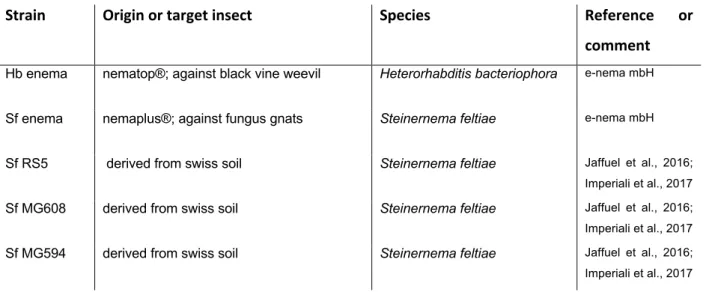
MATERIAL AND METHODS
- H ANDLING THE ORGANISMS USED IN THIS STUDY
- D. radicum rearing
- Entomopathogenic nematode rearing
- Galleria mellonella
- Entomopathogenic pseudomonads propagation
- R ADISH GREENHOUSE EXPERIMENT TO TEST ENTOMOPATHOGENIC P SEUDOMONAS FOR D. RADICUM CONTROL
- Method optimization
- C LIMATE CHAMBER ASSAY TO EVALUATE ENTOMOPATHOGENIC NEMATODE STRAINS FOR D. RADICUM CONTROL
- Direct infection of D. radicum larvae with nematodes
- Screening nematode strains for the control of D. radicum
- C LIMATE CHAMBER ASSAY TO EVALUATE THE COMBINATION OF NEMATODES AND PSEUDOMONADS FOR THE CONTROL OF D
- Method optimization
- I N VITRO ASSAY TO EVALUATE THE SUSCEPTIBILITY OF NEMATODES TO PSEUDOMONADS
- Method optimization
- C O - INFECTION ASSAY OF G. MELLONELLA TO EVALUATE THE COMPATIBILITY OF NEMATODES AND PSEUDOMONADS
- Method optimization
- I N VIVO ASSAY TO EVALUATE THE POTENTIAL OF NEMATODES AS VECTORS FOR PSEUDOMONADS
- Transmission of pseudomonads into G. mellonella on soil
- Transmission of pseudomonads by surface sterilized nematodes
- S TATISTICS
They were stored at 10°C in the dark and before each experiment sick or dead larvae were discarded. Both were covered with aluminum foil and incubated for one week in the climate chamber under controlled conditions (Table 1). Pots were placed in trays in the greenhouse at 22°C for a 16 h light period and at 18°C for 8 h without artificial light and 70% relative humidity.
The pupae were then placed in the dark in a climate chamber under controlled conditions (Table 1). After infection, the pots were covered with aluminum foil and placed in a climate chamber under controlled conditions (Table 1). Experiments with the first combinations of entomopathogenic nematodes and entomopathogenic pseudomonads were tested in the climate chamber.
For the second replication, autoclaved tap water was sprayed over the pot every third day while it was placed in the climate chamber to keep the sand moist. These concentrations correspond to the concentrations used in the EPN-EPP radish combination assay (see chapter 2.4). After infection, Petri dishes were placed in the dark at 24°C and survival was observed every 12 h for the next three days.
25 ml of autoclaved tap water was added to the containers, which were then placed in the dark at 24°C. Four days after the first infection, four larvae per treatment placed on white traps and incubated in the dark (see chapter 2.1.2). Infected larvae were placed in the dark at 24°C and survival was recorded regularly for the next two days.
RESULTS
- R ADISH GREENHOUSE EXPERIMENT TO TEST ENTOMOPATHOGENIC P SEUDOMONAS FOR THE CONTROL OF D. RADICUM
- Root colonization ability of different fluorescent Pseudomonas strains
- Effect of entomopathogenic Pseudomonas on development of D.radicum
- E VALUATION OF ENTOMOPATHOGENIC NEMATODE STRAINS FOR D. RADICUM CONTROL
- Direct infection of D. radicum larvae with nematodes
- Effect of different EPN on D. radicum development on radish bulbs
- C LIMATE CHAMBER ASSAY TO EVALUATE THE COMBINATION OF NEMATODES AND PSEUDOMONADS FOR THE CONTROL OF D
- Effect of a combined entomopathogenic nematode - Pseudomonas application on the development of
- Fluorescent Pseudomonas presence
- I N VITRO ASSAY TO EVALUATE THE SUSCEPTIBILITY OF NEMATODES TO PSEUDOMONADS
- Survival of nematodes when exposed to P. chlororaphis PCL1391
- Survival of pseudomonads when mixed with nematodes
- C O - INFECTION ASSAY OF G. MELLONELLA TO EVALUATE THE COMPATIBILITY OF NEMATODES AND PSEUDOMONADS
- Effect on survival of G. mellonella larvae
- Presence of pseudomonads in G. mellonella larvae after co-infection
- I N VIVO ASSAY TO EVALUATE POTENTIAL OF NEMATODES AS VECTORS FOR ENTOMOPATHOGENIC PSEUDOMONADS
- Transmission of pseudomonads into G. mellonella on soil
- Transmission of pseudomonads by surface sterilized nematodes
In the second repeat of the experiment, colonization was higher for the PCL1391-gfp strain. In the first repetition, the application of PCL1391 and CHA0 reduced the mean pupation rate compared to the control (Table 6, appendix). Two outliers with very small pupal sizes occurred in the control group and the PCL1391-gfp group.
Pupal sizes were small in the second and third replicates, especially in the control treatment. Sf enema reduced pupal size in all replicates compared to control except the first. Sf enema reduced midges in the second and fourth replicates by 73% and 7%, respectively, compared to the control (Table 9, Appendix).
While PCL1391-gfp was used in the first repeat, wild-type PCL1391 was used in the second experiment. At the first recurrence, the mean pupation rate was significantly reduced by the single application of Sf enema compared to the control. In the second replicate, survival of IJs at 72 hours was measured for two concentrations of PCL1391-gfp met.
In the first replication, survival was significantly higher for control and for PCL1391-gfp compared to all other treatments (Figure 17). In the second replication, survival in the control and PCL1391-gfp treatment was lower than in the first replication (Figure 18). In the second replicate, cfu/larva was highest for the PCL1391-gfp control treatment (Figure 20).
In mixed larvae, only in the PCL1391-gfp treatment were pseudomonads present in all four larvae (Figure 22). The survival of Sf MG608, Sf enema x PCL1391-gfp and Sf MG608 x PCL1391-gfp was not significantly lower than the survival in the control.
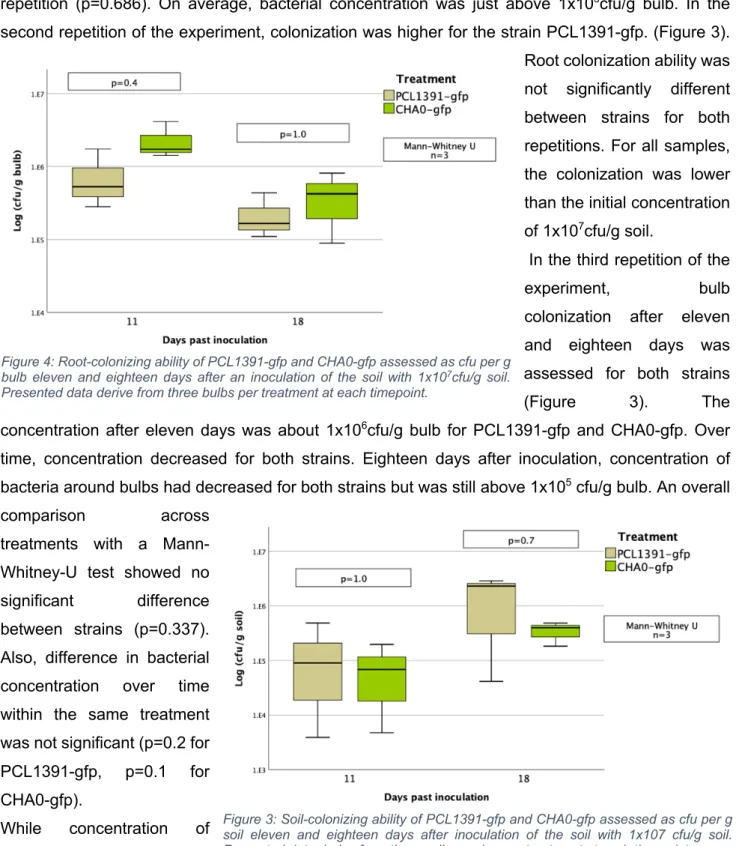
DISCUSSION
- C HALLENGES WHEN EVALUATING EFFECTS ON DEVELOPMENT OF D. RADICUM
- S INGLE ENTOMOPATHOGENIC P SEUDOMONAS APPLICATION TO CONTROL D. RADICUM
- S INGLE ENTOMOPATHOGENIC NEMATODES APPLICATION TO CONTROL D. RADICUM
- P OTENTIAL OF A COMBINED ENTOMOPATHOGENIC NEMATODE - P SEUDOMONAS APPLICATION FOR THE CONTROL OF THE CABBAGE
Plant parts such as roots and tubers may need to be treated with Spinosad to have a sufficient effect on larvae (Herbst et al., 2017). These results are comparable to previously observed experiments performed in the climate chamber (Spescha et al., unpublished). In the present study, CHA0 also did not have an effect on pupation rate and fly emergence of D. radicum, but on pupal size.
In the present study, the potential of five entomopathogenic nematode strains tested to infect D. These findings and observations in the present study highlight the potential of entomopathogenic nematodes for the control of D. radicum as they are able to infect and kill larvae when applied at the time of properly under favorable conditions. In the present study, the combined application of EPN Sf enema and EPP PCL1391 reduced the development of D. Single BCA applications also showed effects, but were not consistent across replicates.
In a study by Imperiali et al. 2017) the combined use of arbuscular mycorrhizal fungi, entomopathogenic nematodes (H. . bacteriophora, S. feltiae) and pseudomonads (P. chlororaphis, P. protegens) proved beneficial. Under conditions of high biotic stress, combinations of nematodes and pseudomonads gave the highest yields (Imperiali et al., 2017). Although entomopathogenic Pseudomonas were recovered from co-infected larvae in this study, bacterial concentrations varied within larvae.
In in vitro experiments conducted in the present study, survival of nematodes was not significantly affected when mixed with entomopathogenic Pseudomonas. This may have been the reason for no survival of nematodes in the tested strain Sf MG594. Performance in the greenhouse and in the field should be evaluated before a conclusion is drawn about the potential of a combined application for the control of D.
CONCLUSION
Future experiments to investigate the interaction of EPN and EPP should focus on the effect of different metabolites of pseudomonads on symbiotic bacteria of EPN and vice versa. The effect of these metabolites plays an important role for the compatibility of EPN and EPP as a crop protection product. For the potential as a crop protection product, the question of whether the interaction of EPN and EPP is commensal or pathogenic when attacking the same host needs to be answered.
Although the present study suggests that EPN and EPP are compatible, experiments at the molecular level are needed to uncover their direct and indirect interactions. Since conditions in the climate chamber appear to be important for nematodes, keeping the pots moist during the experiment, as well as a later time of application of EPN, should be taken into account. To investigate whether EPN can follow the larvae into roots or bulbs, their interaction with Brassicacean plants and their root secretions should be investigated in more detail.
When EPN and EPP are applied simultaneously, a simultaneous application with the infection by D. Method optimization and experiments with a greater number of repetitions can compensate for the high variability in pupation rates and fly emergence rates. In the current study, the effect of a combined EPN-EPP application was indicated as more consistent compared to single BCA applications.
To confirm this assumption of a synergistic effect, further iterations should be done with more replicates to compensate for the large variability in pupation rates and fly emergence rates. Therefore, greenhouse experiments with the most promising EPN and EPP strains under different controlled environmental conditions may be suitable to investigate higher consistency. Since the lack of consistency is a common problem of BCAs under field conditions, the performance under different controlled conditions can demonstrate the limitations and possibilities of a combined EPN-EPP application.
2009) Pseudomonas fluorescens CHA0 can kill the subterranean termite Odontotermes obesus by inhibiting cytochrome c oxidase of the termite respiratory chain. Genome sequence of the entomopathogenic bacterium Photorhabdus luminescens. 1996) Combination of Trichoderma koningii with fluorescent pseudomonads for control of common wheat. The specificity of the association between Paenibacillus spp. and entomopathogenic nematodes, Heterorhabditis spp. 1989) Ecological aspects in the management of Delia pest species in vegetable crops.
Hajek (2018) Natural Enemies: An Introduction to Biological Control, Cambridge University Press. 2002) Study of aphid pathogenic bacteria, isolation of bacteria and identification of insecticidal compound. An investigation into interactions between entomopathogenic nematodes and plant growth-promoting bacteria. 2017) Combined field inoculations of Pseudomonas bacteria, arbuscular mycorrhizal fungi and entomopathogenic nematodes and their effects on wheat performance. Protection of maize from rootworm damage by combined application of arbuscular mycorrhizal fungi, Pseudomonas bacteria and entomopathogenic nematodes.
Kupferschmied, P., Péchy-Tarr, M., Imperiali, N., Maurhofer, M. 2014) Domain shuffling in a sensor protein contributed to the evolution of insect pathogenicity in beneficial plants Pseudomonas protegens J. 2001) Insect pathogens as biological control agents: Do they have a future. 2012) Comparative genomics of plant-associated Pseudomonas spp.: insights into diversity and inheritance of traits involved in multitrophic interactions. New Delhi: Springer India, p. 2002) Biocontrol agent combinations for the management of plant-parasitic nematodes and soil-borne plant-pathogenic fungi. as a model organism used in biomedical and other studies.
2008) Molecular analysis of a novel gene cluster encoding an insect toxin in plant-associated strains of Pseudomonas fluorescens. 1996) The natural host range of Steinernema and Heterorhabditis spp. and their impact on insect populations. 2001) Induction of systemic resistance by plant growth promoting rhizobacteria in crops against diseases and pests. 1992) Biological control of hawthorn blight (Crataegus monogyna) with fluorescent Pseudomonas spp. 2011) Combined use of biological control agents to control plant diseases in theory and practice.
APPENDIX
DECLARATION
